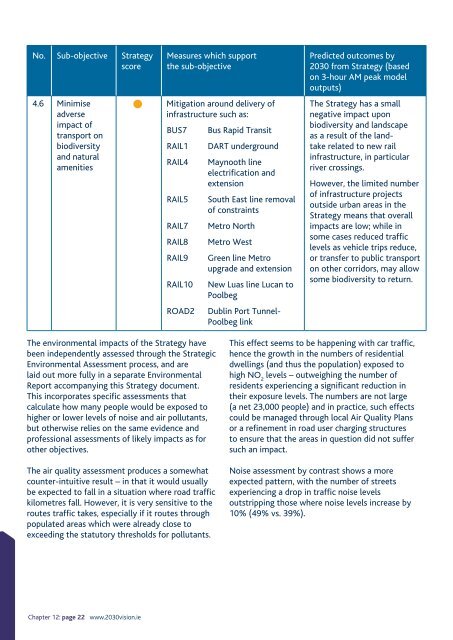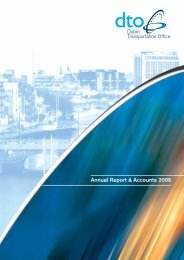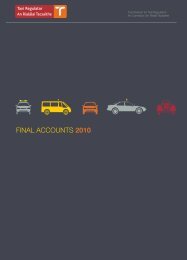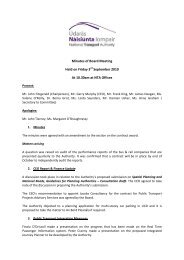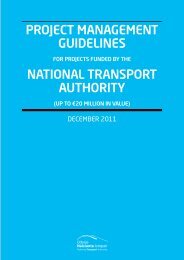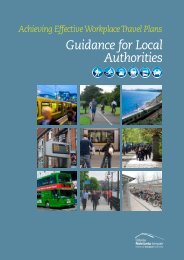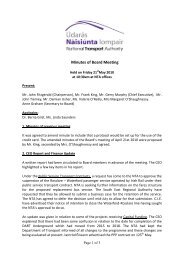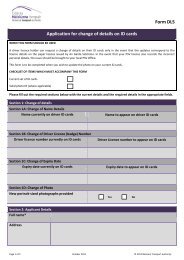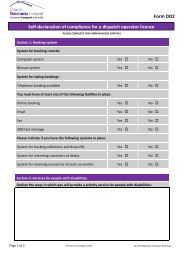Greater Dublin Area Draft Transport Strategy 2011-2030
Greater Dublin Area Draft Transport Strategy 2011-2030
Greater Dublin Area Draft Transport Strategy 2011-2030
- No tags were found...
Create successful ePaper yourself
Turn your PDF publications into a flip-book with our unique Google optimized e-Paper software.
No. Sub-objective <strong>Strategy</strong>score4.6 Minimiseadverseimpact oftransport onbiodiversityand naturalamenitiesMeasures which supportthe sub-objectiveMitigation around delivery ofinfrastructure such as:BUS7RAIL1RAIL4RAIL5RAIL7RAIL8RAIL9RAIL10ROAD2Bus Rapid TransitDART undergroundMaynooth lineelectrification andextensionSouth East line removalof constraintsMetro NorthMetro WestGreen line Metroupgrade and extensionNew Luas line Lucan toPoolbeg<strong>Dublin</strong> Port Tunnel-Poolbeg linkPredicted outcomes by<strong>2030</strong> from <strong>Strategy</strong> (basedon 3-hour AM peak modeloutputs)The <strong>Strategy</strong> has a smallnegative impact uponbiodiversity and landscapeas a result of the landtakerelated to new railinfrastructure, in particularriver crossings.However, the limited numberof infrastructure projectsoutside urban areas in the<strong>Strategy</strong> means that overallimpacts are low; while insome cases reduced trafficlevels as vehicle trips reduce,or transfer to public transporton other corridors, may allowsome biodiversity to return.The environmental impacts of the <strong>Strategy</strong> havebeen independently assessed through the StrategicEnvironmental Assessment process, and arelaid out more fully in a separate EnvironmentalReport accompanying this <strong>Strategy</strong> document.This incorporates specific assessments thatcalculate how many people would be exposed tohigher or lower levels of noise and air pollutants,but otherwise relies on the same evidence andprofessional assessments of likely impacts as forother objectives.The air quality assessment produces a somewhatcounter-intuitive result – in that it would usuallybe expected to fall in a situation where road traffickilometres fall. However, it is very sensitive to theroutes traffic takes, especially if it routes throughpopulated areas which were already close toexceeding the statutory thresholds for pollutants.This effect seems to be happening with car traffic,hence the growth in the numbers of residentialdwellings (and thus the population) exposed tohigh NO 2levels – outweighing the number ofresidents experiencing a significant reduction intheir exposure levels. The numbers are not large(a net 23,000 people) and in practice, such effectscould be managed through local Air Quality Plansor a refinement in road user charging structuresto ensure that the areas in question did not suffersuch an impact.Noise assessment by contrast shows a moreexpected pattern, with the number of streetsexperiencing a drop in traffic noise levelsoutstripping those where noise levels increase by10% (49% vs. 39%).Chapter 12: page 22 www.<strong>2030</strong>vision.ie


